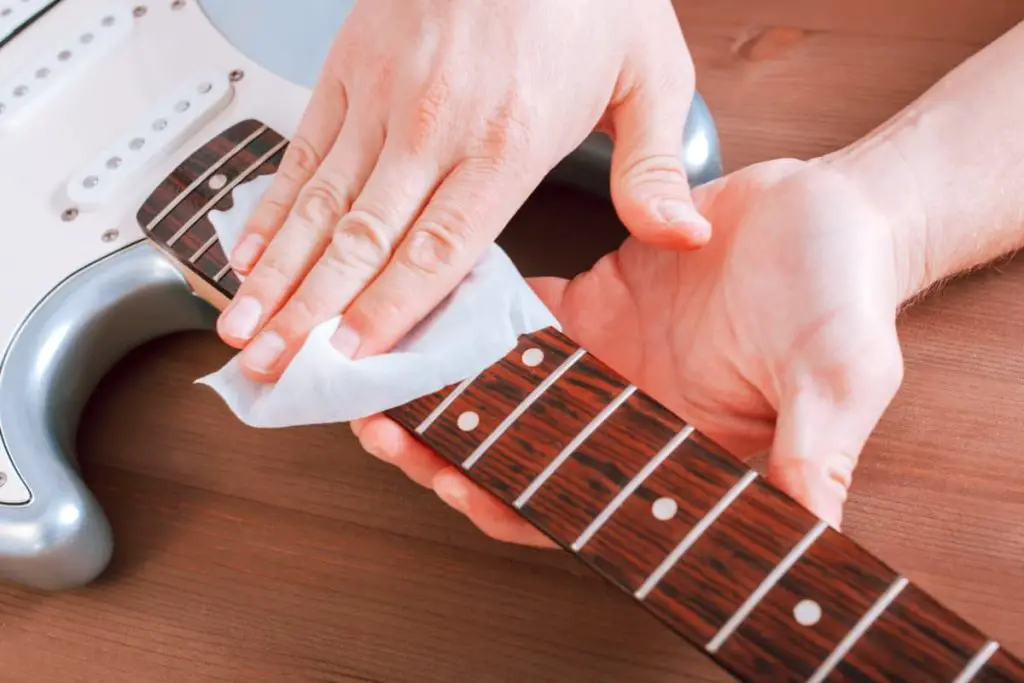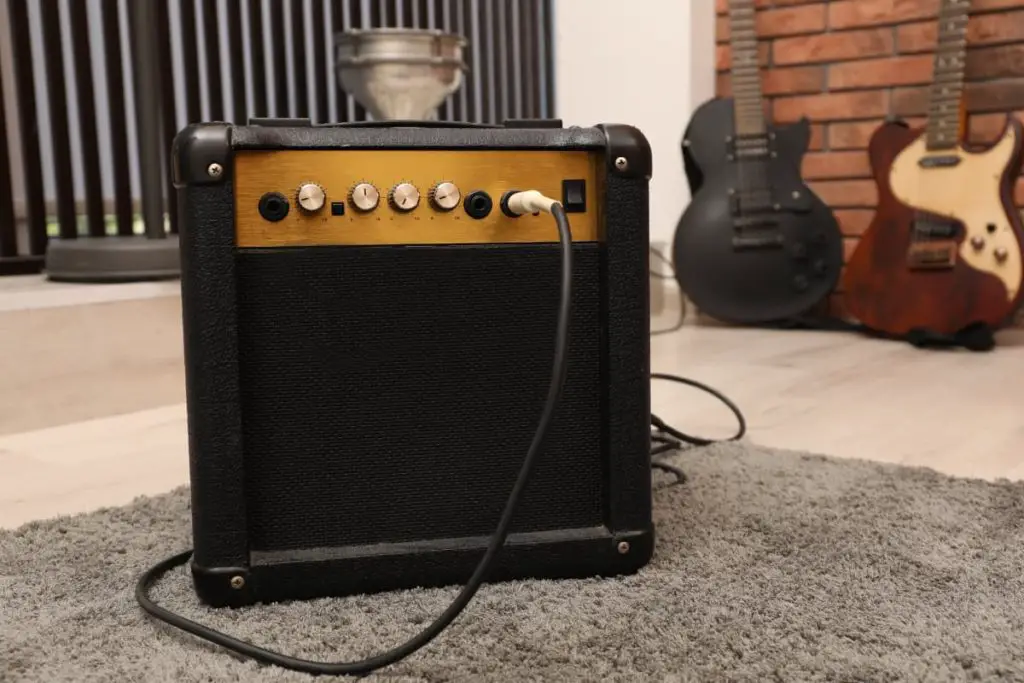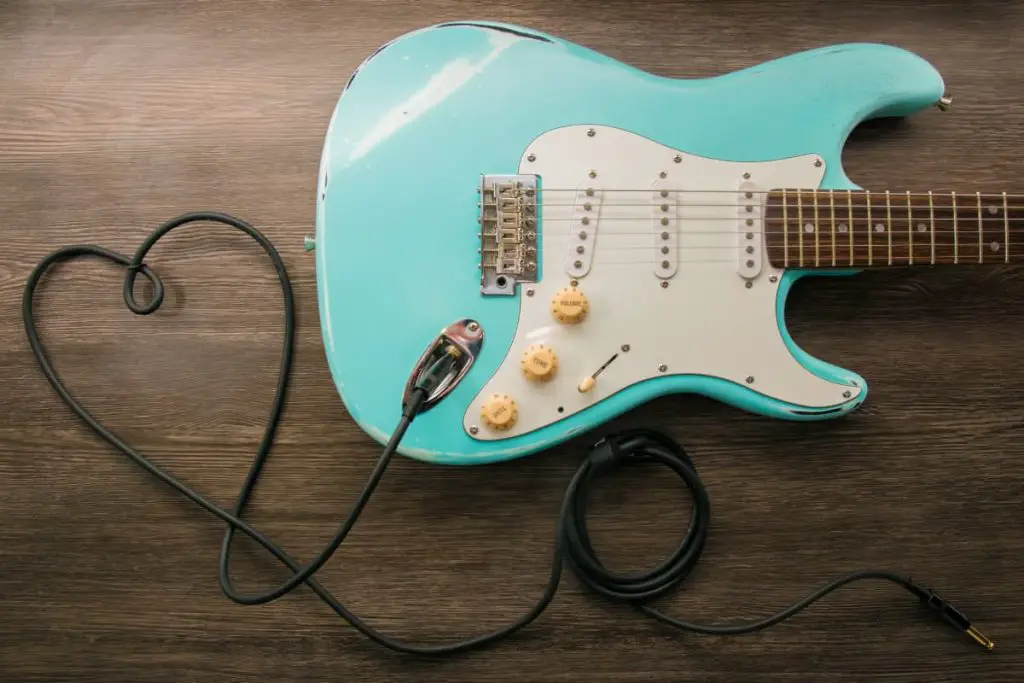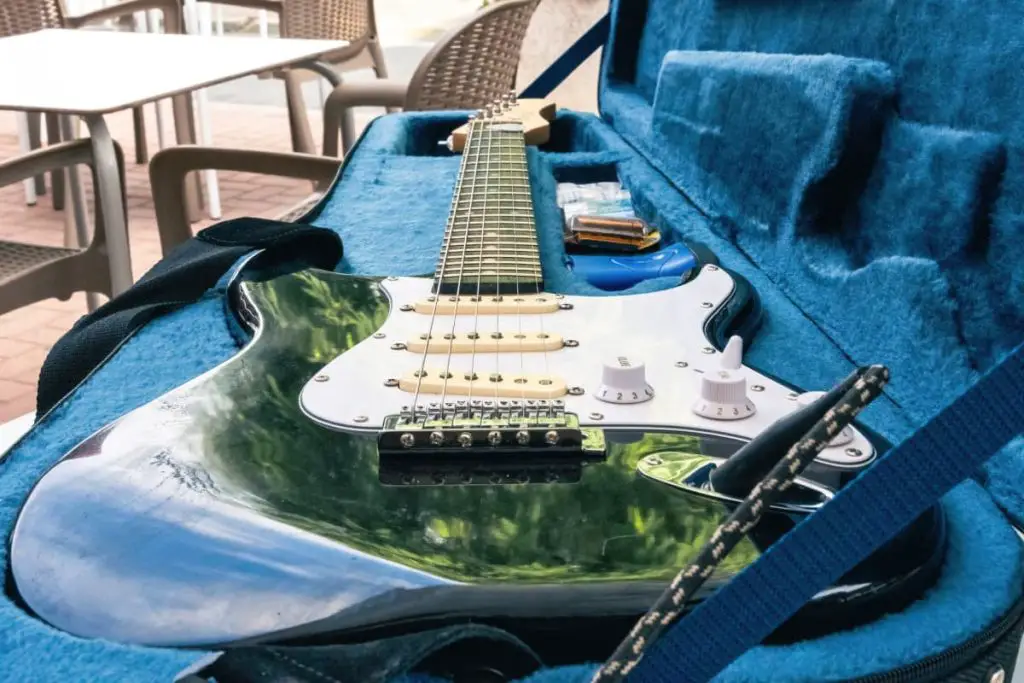With their beautiful look and versatile sound, electric guitars are some of the most popular musical instruments of our time. But as with any piece of electronic equipment, problems can arise. Whether you didn’t set up your electric guitar correctly, or it’s been a while since you last played it, there may come a time when your trusty guitar won’t make a sound when plugged in.
Electric guitars fail to work when plugged in due to electrical issues, worn-out batteries, faulty pickups, and damaged external equipment (amp, PA system, speakers, mixers, etc.) Easy fixes include replacing the batteries and pickups, swapping damaged cables, and troubleshooting electrical issues.
There are ways to fix an electric guitar that won’t work when plugged in – you just have to know where to look! In this article, I’ll give you some troubleshooting tips that will help you find the problem faster and fix your electric guitar if it isn’t working when plugged in.
If you want to find out what my recommended guitar gear is, then here is what I recommend on Amazon:
- Fender Cutaway Acoustic-Electric Guitar Bundle (MY FAVORITE GUITAR)
- Snark SN-8 Super Tight All Instrument Tuner (Easiest Tuner I’ve Used)
- 6 String Acoustic Guitar Capo (Best CAPO for quick changes)
- Dunlop Max Grip 1.0mm Nylon Picks (Thick Guitar Pick So You Don’t Lose Grip!)
- Universal Guitar Stand (Cheap & Minimalist Guitar Stand I Recommend)
- Levy’s 2″ Wide Quick Adjust Guitar Strap (Best Guitar Strap For Any Level)

5 Fixes for an Electric Guitar That Won’t Work When Plugged In
Fixing an electric guitar that doesn’t work when plugged in is easy, but finding the exact cause of the issue is the tricky part. If your guitar doesn’t work when you plug it in, then you have some extensive troubleshooting to do.
There are numerous reasons why an electric guitar might not work when plugged in, from the cable, the jack, the input on your amp, or the output on your guitar.
1. Check Your Guitar Cable
There’s nothing flashy about a broken electric guitar cable. Electric guitar cables transmit the audio signals from your guitar to the amplifier, PA system, DAW, or whatever you have connected to the other end of the cable. But just like any other piece of equipment, electric guitar cables can break and malfunction.
These cables are constantly being plugged into the guitar and out of it, which reduces their durability over time. Additionally, the storage conditions may have an impact on the health and life span of the cable.
You should always check the condition of your electric guitar cord before playing. Feel the length of the cable.
If you spot any tugging or see fraying on the cords or plugs, do not risk playing your instrument and instead take time to replace the cable with a new one that’s in excellent condition.
I like to hold the cable at the connector and jiggle the cable gently while plugged in. If you hear weakening sounds or crackling sounds, it’s probably because of a faulty cord.
To improve the durability of your cords, store them in a humid-free environment. Check out more ways to store guitar cables.
2. Check for Dust and Gunk
Dust can be a serious problem for your electric guitar. The dust and dirt caught in the strings and fretboard can affect how your guitar sounds. The plastic parts of the guitar, especially around the bridge and pickup area, are prone to collecting dust because they’re not covered like other areas.
But that’s not all. Tiny dust particles may also settle on the electronics inside the guitar. If yours has a preamp, the dust may weigh down its performance or cause it to fail completely which in turn would produce very little to no sound.
For this reason, you need to be equipped with the following tips to clean your guitar:
- Get a soft cloth and wipe the body and fretboard of the guitar
- Remove the guitar strings and wipe them clean. Doing this will also make it easier to access the fretboard
- Use fine steel wool to remove stubborn patches
- Apply non-abrasive polish for a polished body guitar
But most importantly, keep your (clean) guitar in its case when not in use. This will significantly reduce the amount of dust that accumulates with time.

3. Replace the Pickup
The pickup is a crucial part of an electric guitar. It’s the part that “picks up” the inaudible sound produced by the strings. You’ll have trouble getting a good sound if it’s not working properly. If you notice that the pickup has broken wires, you’ll need to get a new one.
You can usually find these parts online or at a local music shop. If the pickup is connected to a patch cable, you might want to get a new one too.
Here’s how to replace your electric guitar pickup if you have a little bit of experience with a soldering iron:
- Buy new pickups. I recommend buying the same type of pickup you had on your guitar. This will ensure that it fits in perfectly and that the wiring doesn’t get complicated.
- Set up your workstation. You should have a sharp blade, a clean cloth, a soldering iron and wire, and a screwdriver on your work desk.
- Remove the guitar wires from the tuning keys and the tailpiece.
- Open the backplate by unscrewing the screws holding it in place.
- Snap a picture of the current wiring. It would help if you downloaded the wiring diagram from the pickup manufacturer’s website. Also, some pickups come with wiring diagrams.
- Using your soldering iron, touch the contacts holding the pickup wire to the potentiometer and remove the wires.
- Install the new pickup and refer to your wiring diagram to solder its wires in place.
- Test your guitar and adjust the height of the pickup
Installing new pickups is something you may be forced to do every now and then. The process is straightforward.
However, if you need more help, the video below highlights how to replace your pickups:
4. Troubleshoot Your Amplifier
An electric guitar needs an amp to perform for a large audience. But just like other electrical instruments, the electric guitar amp is susceptible to dust, moisture, dirt, loose contacts, and other issues that cripple its performance.

Here’s how to troubleshoot your amplifier:
- Rule out external issues by trying a different amp. If it helps, borrow an amplifier and test its performance in your old setup. If the new amp works and your guitar sounds fine, the problem is with the old amp.
- Check for loose contacts. After years of plugging and unplugging, your amplifier’s input and output jacks may get damaged. Test your guitar cable by connecting it to a different amp and touching its bare end. It should make a humming noise. This rules out the possibility of a defective cable.
- Check the LED lighting. If your amp lights up when it’s turned on, the LED lights should light up as well. If they don’t, you could be dealing with a power issue.
- Try a different power cable for your amp.
Depending on what issue you find, you may try to fix it yourself or ask an expert for help. You may also purchase a new amplifier, although this should be your last option if nothing else works.
5. Troubleshoot the PA System (Speakers & Mixer Included)
Public address systems or PA systems are sound amplification devices designed to make sound audible to an audience in a public space. They can be used for a variety of purposes, from alerting people to emergencies to gigging.
If your guitar doesn’t make a sound after plugging it in, you could be facing a PA failure. Speakers, mixers, and other electronic components are easily damaged over time due to movement, drops, and several other causes. To troubleshoot yours,
- Check for damaged wires. Signal-carrying wires are easily damaged due to lots of movement. Check each wire and ensure that they’re all in perfect working order.
- Scan for power issues. Is the power input functioning well? Are the power cables in good health? Does the system power up when it’s on? If you answered yes to all these questions, you probably have nothing to worry about.
- Control issues. Sometimes, your equipment could be muted or reset in such a way that it produces inaudible sounds, which can be readjusted by tweaking the volume, gain, and tone control buttons.
- Last but not least, check for irreparable damage such as burnt PCB and other irreversible damage.
Depending on the extent of the damage, you may choose to have your equipment repaired by a professional or buy new equipment altogether.
Common Electric Guitar Issues
Electric guitars are complicated instruments. They’re full of different components that all need to work harmoniously to produce a pleasant sound. If your electric guitar isn’t making the kind of sound you want, there could be a few problems, from wiring issues and amp problems.
But, if no sound comes out at all, you might need a better understanding of the common issues, to give you a clearer idea of what to look for.
Electrical Issues
An electric guitar has a pickup, a volume knob, a tone knob, a preamplifier, and switches on its body. All these electrical components serve two main functions: they capture the string’s vibrations, turn it into sound, and control its features before sending the signal to the main speakers.

All of these little components pave the way for a myriad of electrical problems such as:
- Damaged pickups. Electric guitar pickups are the little magnets that capture and amplify the vibration of your strings. When they’re working properly, they produce a bright and clear sound. But after years of being whacked on things, dropped, sweated on, and generally mistreated, they may malfunction and fail to capture sound like they used to when they were new.
- Loose control knobs. Electric guitar knobs can be loose for several reasons. You may have dropped your guitar a couple of times, or maybe you’ve just played so much that the knob has become loose with time. Unless you’re willing to put up with crackling distortion and awkward volume changes, you need to do everything in your power to keep them in good working order.
- Loose input jacks. If you plug your electric guitar into an amp and hear a crackling noise, static, or no sound at all, you probably have one of the guitar’s loose input jacks. Too much physical stress on the jack over time can cause these parts to loosen and, in some cases, completely fall out.
- Dusty electronics. Dust is a natural enemy to electronic devices, including the tiny transistors and diodes inside your electric guitar. Years of dust build-up on your trusty guitar bring up a lot of problems, including random signal cut-offs, crackling, or no sound at all in extreme cases.
Dead Batteries
Most electric guitars don’t need a battery to run their pickups. These guitars use inactive pickups, which essentially means that they don’t need a current flowing through the pickup to capture the string vibrations.
For those that need batteries, like the Traveler Guitar EG-1 (available on Amazon.com), you’ll have to replace the batteries every two months (or longer, depending on your model). Otherwise, you may not get any sound from the instrument. Fortunately, electric guitar batteries are standard 9-volt alkaline batteries that you can buy at any electronics store or supermarket.
Broken Strings
Playing your guitar puts the strings under stress. They have to be able to withstand constant movement while being struck at different intensities. If your strings break often or are difficult to tune, it might not be your fault. You just need new ones.
You may not realize it yet, but the steel strings on your guitar are easier to break than you think. Even with careful maintenance, they can break or become dull over time. If this happens, stop playing your guitar and take the broken string out.
You can replace the string at home with relative ease. Just make sure you buy the same type and gauge.
Your Amp Is Causing Problems
A guitar amplifier is an essential piece of equipment for any electric guitarist. It will boost the volume of your guitar so you can hear it while playing. It will also come in handy when adding distortion and various other effects to give your guitar a unique sound. The output jacks send the audio signal to the main speakers, where you and your audience can enjoy the music.
If you’re playing through an amplifier, there’s a chance that it’s the source of the problem. If you notice that your guitar doesn’t sound right when you increase or decrease the amp’s volume, it’s a clear indication that the amp might be the problem.
The Body, Bridge, or Nut Is Bent or Out of Position
If your bridge or nut is bent or crooked, you might notice that the sound is coming out of tune. You might also hear a clicking noise. If that’s the case, you’ll need to get it fixed by a professional.
The same goes if the body of your guitar is bent. It might be hard to play. Such problems are best handled by a professional.
Essential Tips for Taking Good Care of Your Electric Guitar
Electric guitars can be delicate instruments that require special care to keep them in peak playing condition. Taking good care of the instrument can prevent future issues. I’ve outlined these few tips to help you take good care of your guitar:
Store Your Guitar Properly
The best way to protect your guitar is to store it properly. To do this, find a suitable storage place. A good guitar case offers the perfect environment free from humidity, direct sunlight, dust, and objects that could scratch its surface.

If you don’t have a case, the bedroom closet is a decent place to store your guitar, as long as it’s not too humid inside.
Check the Condition of Your Strings Regularly
Regularly check the condition of your strings. If you see any rust, chipping, or other signs of wear and tear, it’s time to change them.
The average lifespan of an electric guitar string is between three and six months. When the time comes, change them all at once to avoid having to restring the guitar more often than you should.
Be Gentle With Your Pickups and Other Sensitive Parts
The knobs and switches on your guitar are extremely delicate. Never try to twist it with a lot of force. Always grab the knob by the side. If a knob is broken or loose, get it fixed as soon as possible.
Protect Your Guitar With a Solid Case
If you don’t already have a guitar case, it’s time to get one for your guitar. The best guitar cases are sturdy and secure. You don’t want a flimsy case that will let your guitar get damaged while you’re transporting it. Always put the guitar in the case before transporting it. You may also want to invest in a humidifier.
A humidifier can help prevent the wood in your guitar from drying out and cracking. You’ll want to use a humidifier regularly if you have a guitar with a maple or spruce top. Put the humidifier in the case with your guitar.
Regular Cleaning and Polishing
Keeping your guitar clean and polished can help it stay healthy for longer. You should clean your guitar at least once a week and polish it once a month.
You can use a gentle cleaning solution made especially for guitars. Simply wipe the guitar down with a sponge or soft cloth. Make sure you clean the fretboard and frets as well.
Go Easy on the Volume and Gain
Playing with too much volume and gain can cause damage to your speakers. It can also cause clipping and too much distortion. If you’re experiencing any of these problems, turn down the volume and gain.
The life of an electric guitar depends on how well you look after it. Neglecting your guitar may result in irreparable damage, which may even render your guitar unplayable.
Conclusion
Taking care of your electric guitar doesn’t have to be a difficult process. You just have to remember to keep it clean and dry, regularly change your strings, protect it from extreme temperatures, and don’t play it too loudly. If any issues arise even after taking good care of your guitar, the tips highlighted in this article can point you in the right direction.
Electric Guitar Not Working FAQ
Here are some common questions you may have.
Why does my electric guitar have no sound when plugged in?
There could be several reasons why your electric guitar has no sound when plugged in. Here are some possible causes:
- Volume or tone controls are turned all the way down: Check to make sure that the volume and tone controls on your guitar are turned up.
- Faulty cables: The cable connecting your guitar to the amplifier may be faulty or damaged. Try using a different cable to see if that solves the problem.
- Dead battery: If you have an active pickup system that requires a battery, the battery may be dead or dying. Replace the battery and see if that solves the problem.
- Faulty pickups: The pickups on your guitar may be faulty or damaged. This can be caused by a number of factors such as corrosion, wiring issues, or physical damage. If this is the case, you may need to take your guitar to a technician to have the pickups replaced.
- Amp or speaker issues: The problem may not be with your guitar at all, but rather with your amplifier or speaker. Try plugging your guitar into a different amp to see if the problem persists.
If you’ve tried these solutions and your guitar still has no sound when plugged in, it may be best to take it to a professional guitar technician for further diagnosis and repair.
Why is my guitar not playing through my amp?
If your guitar is not playing through your amp, here are some possible reasons why:
- The volume on your guitar is turned all the way down: Check to make sure the volume on your guitar is turned up.
- The volume on your amplifier is turned all the way down: Check to make sure the volume on your amplifier is turned up.
- The cable connecting your guitar to the amplifier is faulty or damaged: Try using a different cable to see if that solves the problem.
- The amplifier or speaker is not working: If the amplifier or speaker is not working properly, it will not produce sound. Check to see if the power is on and that all the connections are secure.
- The guitar’s output jack is loose or damaged: Check to make sure the output jack on your guitar is secure and not loose. If it is loose or damaged, it may need to be replaced.
- The guitar’s pickups are not working: If the pickups on your guitar are not working, you will not get any sound from your amp. This can be caused by wiring issues, corrosion, or physical damage.
What are common problems with electric guitars?
Here are some common problems that electric guitars may encounter:
- Intonation issues: This occurs when the guitar is not properly tuned and adjusted to play in tune across all frets. Intonation problems can be caused by several factors, such as an improperly adjusted bridge, worn-out frets, or a poorly cut nut.
- String buzzing: This is when the strings buzz against the frets when played. Buzzing can be caused by a number of issues, including improper string height, a warped neck, or loose frets.
- Electronics problems: Electric guitars have electronic components such as pickups, potentiometers, and switches, which can become damaged or worn over time. Problems with the electronics can cause issues such as no sound, distorted sound, or a loss of volume.
- Loose hardware: Screws, nuts, and other hardware can become loose over time, which can cause buzzing, rattling, or other unwanted noises.
- Warped neck: Changes in temperature and humidity can cause the neck to warp, which can cause tuning and playability issues.
- Cracked or damaged body: Physical damage such as cracks or dents can affect the sound and playability of the guitar.
- Faulty or damaged input jack: The input jack is the part of the guitar where the cable plugs in. If it is damaged or worn out, it can cause issues such as crackling, cutting out, or no sound at all.
- Dead or weak batteries: Some electric guitars have active electronics that require a battery to function. If the battery is dead or weak, it can cause issues with the sound or volume.
How do I know if my guitar cable is working?
To check if your guitar cable is working, follow these steps:
- Plug one end of the cable into your guitar’s output jack.
- Turn the volume on your guitar up to a reasonable level.
- Plug the other end of the cable into your amplifier’s input jack.
- Turn the volume on your amplifier up to a reasonable level.
- Strum a chord on your guitar. If you hear sound coming through your amplifier, your cable is working.
If you do not hear any sound, try these additional steps:
- Wiggle the cable gently at the guitar and amplifier ends. If you hear any crackling or popping sounds, it may indicate that the cable is faulty or damaged.
- Try using a different cable to see if that solves the problem.
- Check the input jacks on both the guitar and amplifier to make sure they are clean and free from dust or debris. Dirty input jacks can cause poor connections and affect the sound quality.
- Check the battery if your guitar has active pickups that require one. If the battery is dead, it can cause no sound or a weak signal.
How do I know if my electric guitar strings are dead?
Electric guitar strings can become “dead” over time, meaning that they lose their tone and responsiveness. Here are some signs that your electric guitar strings may be dead:
- Dull tone: Dead strings will sound dull and lifeless, with little sustain or resonance. You may notice that your guitar sounds “dead” or “thuddy.”
- Lack of clarity: Dead strings can cause notes to sound muted or unclear, with less definition and separation between each note.
- Difficulty tuning: As strings become dead, they can become more difficult to tune accurately. You may find that your guitar is out of tune more often than usual, even after tuning it.
- Rough texture: Dead strings can develop a rough texture or feel gritty to the touch. They may also start to discolor or rust.
- Reduced playability: Dead strings can be more difficult to play, with increased tension and less flexibility. You may find that your fingers are getting tired more quickly or that it’s harder to play fast or intricate passages.
If you notice these signs, it’s probably time to replace your guitar strings. It’s recommended to change your strings every few months, depending on how frequently you play and how often you perform. Fresh strings can help to improve the tone, playability, and overall sound of your guitar.
How many years do electric guitars last?
With proper care and maintenance, an electric guitar can last for decades or even a lifetime. Here are some factors that can affect the lifespan of an electric guitar:
- Quality of materials: Higher-quality materials, such as solid woods and high-end hardware, can withstand wear and tear better than cheaper materials. A well-made guitar can last for many years with proper care.
- Frequency of use: The more often you play your guitar, the more wear and tear it will experience. However, playing regularly can also help to keep the guitar in good condition by preventing dust and debris from building up.
- Level of maintenance: Regular maintenance, such as cleaning, string changes, and adjustments to the truss rod and intonation, can help to extend the life of your guitar. Neglecting maintenance can lead to issues such as rust, corrosion, and damage to the electronics.
- Environmental factors: Exposure to extreme temperatures, humidity, and sunlight can damage the finish and components of an electric guitar over time. It’s important to store your guitar in a cool, dry place when not in use.
- Playing style: Heavy playing styles, such as aggressive strumming or heavy bending, can put extra stress on the guitar’s components and wear them out more quickly.
How do I reset my electric guitar?
Resetting an electric guitar can mean different things depending on what you want to achieve. Here are some steps to follow for different types of guitar resets:
- Resetting the guitar’s intonation: If your guitar’s intonation is off and you want to reset it, follow these steps:
- Tune your guitar to pitch.
- Play a note at the 12th fret and compare it to the same note played open. If the note at the 12th fret is sharp or flat, the intonation needs to be adjusted.
- Use a screwdriver to adjust the saddle position on the bridge until the note at the 12th fret is in tune with the open string.
- Resetting the guitar’s action: If the action (height of the strings from the fretboard) is too high or low and you want to reset it, follow these steps:
- Loosen the strings by turning the tuning keys counterclockwise.
- Use an Allen wrench to adjust the saddle height screws on the bridge. If the action is too high, lower the saddles. If the action is too low, raise the saddles.
- Retune the guitar to pitch and check the action. Repeat the process until the action is at the desired height.
- Resetting the guitar’s electronics: If the guitar’s electronics are not working properly and you want to reset them, try these steps:
- Check that the guitar is properly plugged in and that the cable is not faulty.
- Check the volume and tone knobs to make sure they are turned up.
- Check the pickup selector switch to make sure it’s in the right position.
- If the problem persists, take the guitar to a professional technician for diagnosis and repair.
How do I get my electric guitar to play sound?
To get your electric guitar to play sound, you’ll need to follow these basic steps:
- Plug your guitar into an amplifier: Your guitar should have a cable that connects to the amplifier. Plug one end of the cable into your guitar’s output jack and the other end into the input jack on the amplifier.
- Turn on the amplifier: Make sure the amplifier is turned on and that the volume is turned up.
- Tune your guitar: Make sure your guitar is in tune using an electronic tuner or a tuning app. This will ensure that the notes you play sound correct.
- Play your guitar: Once your guitar is plugged in and tuned, you should be able to play it and hear the sound coming through the amplifier. Adjust the volume and tone controls on the amplifier and the guitar to get the desired sound.
If you’re not hearing any sound or are having trouble getting your guitar to play through the amplifier, check the following:
- Make sure the guitar is plugged in securely.
- Check the cable to make sure it’s not damaged or faulty.
- Check the amplifier to make sure it’s turned on and the volume is turned up.
- Check the guitar’s battery if it has active pickups that require one.
- Check the guitar’s input jack to make sure it’s clean and free from debris.
If you want to find out what my recommended guitar gear is, then here is what I recommend on Amazon:
- Fender Cutaway Acoustic-Electric Guitar Bundle (MY FAVORITE GUITAR)
- Snark SN-8 Super Tight All Instrument Tuner (Easiest Tuner I’ve Used)
- 6 String Acoustic Guitar Capo (Best CAPO for quick changes)
- Dunlop Max Grip 1.0mm Nylon Picks (Thick Guitar Pick So You Don’t Lose Grip!)
- Universal Guitar Stand (Cheap & Minimalist Guitar Stand I Recommend)
- Levy’s 2″ Wide Quick Adjust Guitar Strap (Best Guitar Strap For Any Level)
Related Posts:
- 10 Best Lightest Electric Guitars that Play & Sound Great!
- Is Learning Electric Guitar Worth It? How To Decide
- How To Put an Electric Guitar Back Together (7 Steps to Assemble Electric Guitar)
- How To Put Binding on an Electric Guitar
- How To Tune Your Electric Guitar Without an Amp
- How To Install a Whammy Bar on Your Electric Guitar
- How To Make an Electric Guitar Sound Better for Metal
- 10 Ways to Make Your Electric Guitar Louder
- How to Practice Electric Guitar in an Apartment
- What To Do When Your Electric Guitar Sounds Muffled
- Why Do Acoustic Electric Guitars Need Batteries?
- Guitar Amp Not Working but a Light Is On? How To Fix It
- 22 vs 24 Fret Electric Guitars: What’s The Difference?
- Best Electric Guitars

